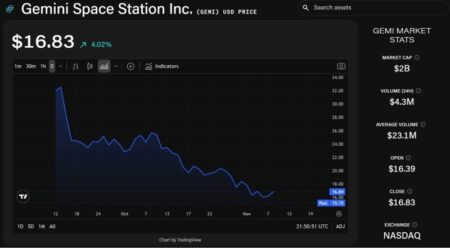Greenidge Generation Holdings (GREE) Celebrates Permit Renewal: A Turning Point for Bitcoin Mining and Emissions Reduction
In a significant development on the financial landscape, shares of Greenidge Generation Holdings Inc. (ticker: GREE) surged by over 30% at Monday’s opening. This dramatic increase follows the company’s announcement that it has secured a renewed air-emissions permit from the New York State Department of Environmental Conservation for its Dresden facility. The new five-year permit, finalized last Friday, solidifies Greenidge’s operations at the intersection of cryptocurrency mining and power generation while committing to ambitious emissions reduction goals.
The renewal of the air-emissions permit is transformative, allowing Greenidge to continue its combined operations. More importantly, the permit mandates that the company cuts its permitted greenhouse gas output by 44% and actual emissions by 25% by the decade’s end. This commitment aligns with the state’s Climate Leadership and Community Protection Act (CLCPA), a move that substantially eases previous tensions between Greenidge and state regulators following a 2022 permit denial. According to Dale Irwin, Greenidge’s president, the updated permit signifies a breakthrough that exceeds existing state requirements and validates the firm’s operational model, which can swiftly adjust power allocations to meet grid demands.
The renewed permit represents a shift in the regulatory landscape for Greenidge Generation Holdings, highlighting its commitment to environmentally responsible practices while promoting its business interests in cryptocurrency mining. This marks a turnaround from the previous year when the company faced public backlash from environmental groups and officials who delayed the renewal of its permit. Greenidge has always maintained that it complies with state laws, indicating that its innovative model of intertwining energy production with cryptocurrency mining is evolving in a way that enhances grid stability while minimizing environmental impacts.
The Dresden facility serves two critical functions; it generates power and hosts a behind-the-meter data center specifically designed for Bitcoin mining. This dual-functionality underscores a larger trend among utilities that are exploring innovative solutions to balance electricity supply and demand. For instance, in Japan, the bitcoin mining sector is increasingly becoming a tool for regulating electricity systems, exemplified by Canaan’s recent partnership with a regional power company on a project that utilizes mining to stabilize grid demand.
This partnership is emblematic of the growing acceptance of cryptocurrency mining as a viable option for utility companies facing challenges in managing energy distribution. As more organizations recognize the potential of Bitcoin mining in optimizing grid operations, we may see a broader trend in energy markets that embraces hybrid models. Greenidge’s recent developments demonstrate that it is possible to foster sustainability in both energy generation and cryptocurrency operations, paving the way for new business partnerships and innovations in the space.
In conclusion, Greenidge Generation Holdings’ successful permit renewal is a watershed moment not just for the company, but for the cryptocurrency mining industry as a whole. By committing to aggressive emissions cuts while continuing to operate its facility, Greenidge is positioning itself as a leader in integrating clean energy practices into cryptocurrency mining operations. As the industry evolves, it will be crucial for companies to adopt similar practices if they wish to navigate the increasingly complex regulatory environments while remaining competitive in a rapidly changing market. This development could herald a new era of sustainable cryptocurrency mining, affirming that corporate responsibility and profitability can coexist harmoniously.
Given the growing convergence of energy generation and cryptocurrency mining, the significance of Greenidge Generation Holdings’ recent permit renewal cannot be overstated. As other firms look to follow suit, the potential for combining clean energy initiatives with cryptocurrency operations will likely draw further investment and innovation in the sector, providing much-needed momentum to the often-controversial industry.
















